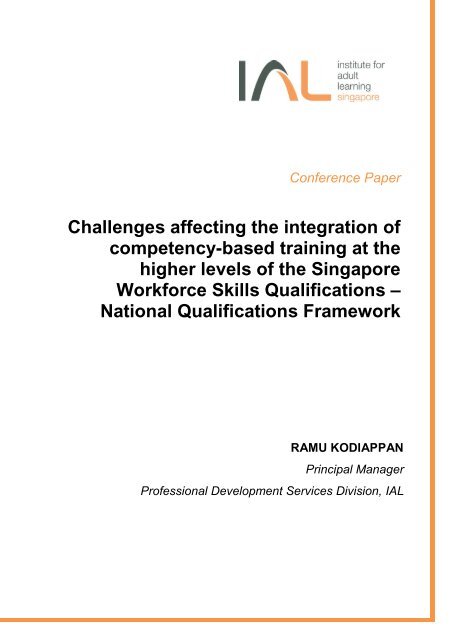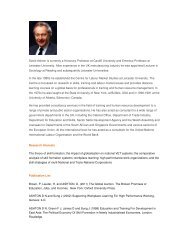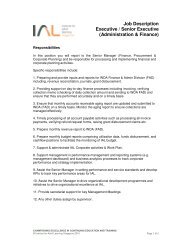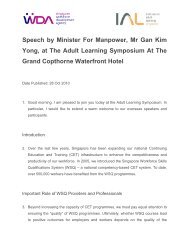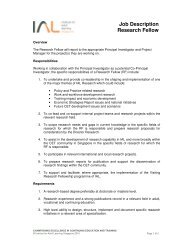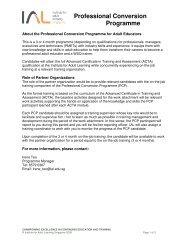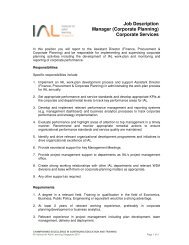Challenges affecting the integration of competency-based training at ...
Challenges affecting the integration of competency-based training at ...
Challenges affecting the integration of competency-based training at ...
You also want an ePaper? Increase the reach of your titles
YUMPU automatically turns print PDFs into web optimized ePapers that Google loves.
authorized to use <strong>the</strong> WSQ n<strong>at</strong>ional <strong>competency</strong> standards as <strong>the</strong>ir referencepoint for developing WSQ accredited CBT programmes for <strong>the</strong> purpose <strong>of</strong><strong>training</strong>, assessing and certifying <strong>the</strong>ir workers as having <strong>at</strong>tained n<strong>at</strong>ionalstandards requirements (WDA 2007a, p 9 and 2007b, p 1).26 industry or sector level WSQ frameworks have been implemented rangingfrom ―Retail‖ to ―Textile & Fashion Technology‖, (WSQ, 2010a). The <strong>training</strong>and assessment <strong>of</strong> <strong>the</strong>se WSQ programmes are delivered by <strong>the</strong> respectivesector’s WDA accredited ATOs or CET Centres which has resulted in some280,000 workers benefitting from ―WSQ quality <strong>training</strong> with 671,216St<strong>at</strong>ements <strong>of</strong> Attainments issued‖, as <strong>of</strong> 2010, (WDA 2010c).Questions and Concerns RaisedEven though thousands <strong>of</strong> adult learners in Singapore have been assessed as―competent‖ over <strong>the</strong> past six years, <strong>the</strong> st<strong>at</strong>istics indic<strong>at</strong>e th<strong>at</strong> a significantlyhigh portion <strong>of</strong> <strong>the</strong> WSQ <strong>training</strong> and assessment conducted was for <strong>the</strong> lowertiers <strong>of</strong> WSQ qualific<strong>at</strong>ion levels 1 targeting mostly <strong>the</strong> rank-and-file―oper<strong>at</strong>ional‖ and ―supervisory‖ level competencies <strong>of</strong>fered within <strong>the</strong> WSQlevels 1 to 3. A strikingly low r<strong>at</strong>e <strong>of</strong> WSQ <strong>training</strong> has been developed forPr<strong>of</strong>essionals, Managers, Executives and Technicians (PMETs) levels duringthis same period addressing higher level competencies (from WSQ level 4onwards).[Note: ―PMET‖ is a broad occup<strong>at</strong>ional c<strong>at</strong>egory used by Singapore’sgovernment agencies to distinguish occup<strong>at</strong>ional mobility, labour, economicand social trends pertaining to <strong>the</strong> segment <strong>of</strong> popul<strong>at</strong>ion within Singapore’sworkforce who already possess recognised diploma and above highereduc<strong>at</strong>ion level qualific<strong>at</strong>ion/s (adapted from MOM, 2010)].It is possible to infer th<strong>at</strong> <strong>the</strong> apparent imbalance between <strong>the</strong> extent <strong>of</strong> lowerand higher levels <strong>of</strong> WSQ <strong>training</strong> programmes developed, presentsresearchers with a snapshot <strong>of</strong> <strong>the</strong> level <strong>of</strong> support or reserv<strong>at</strong>ions harbouredamong current WSQ practitioners for or against <strong>the</strong> use <strong>of</strong> CBT approach <strong>at</strong>differing levels <strong>of</strong> <strong>the</strong> WSQ system.The high level <strong>of</strong> concern held by WSQ policymakers surrounding <strong>the</strong>challenges faced by WSQ practitioners’ in <strong>the</strong>ir <strong>integr<strong>at</strong>ion</strong> <strong>of</strong> CBT approach <strong>at</strong>higher level WSQ programmes for PMETs, is brought into perspective when<strong>the</strong> current imbalance is viewed against <strong>the</strong> backdrop <strong>of</strong> <strong>the</strong> Singaporegovernment’s announcement <strong>of</strong> a S$2.5 billion budget expansion <strong>of</strong> itsinvestment in CET over <strong>the</strong> next few years, (Singapore Budget 2010). TheSingapore government has announced plans to expand <strong>the</strong> reach <strong>of</strong> WSQsystem fur<strong>the</strong>r, as part <strong>of</strong> initi<strong>at</strong>ives to scale up workforce productivity <strong>at</strong> an<strong>at</strong>ional level for <strong>the</strong> country to achieve <strong>the</strong> next stage <strong>of</strong> economiccompetiveness <strong>at</strong> <strong>the</strong> global level. Over 250,000 PMETs are expected tobenefit from CET by 2015 (Hansard, 2011) and a significant amount <strong>of</strong> <strong>the</strong>learning is expected to be <strong>at</strong>tained through WSQ <strong>training</strong> programmes1 The WSQ Qualific<strong>at</strong>ions Levels: Level 1= Certific<strong>at</strong>e, Level 2= Higher Certific<strong>at</strong>e, Level 3= AdvancedCertific<strong>at</strong>e, Level 4 = Diploma, Level 5 = Specialist Diploma andLevel 6 = Gradu<strong>at</strong>e Certific<strong>at</strong>e / Gradu<strong>at</strong>e DiplomaCopyright © 2011 Institute for Adult Learning 2
UK and Australia to review <strong>the</strong>ir respective NQF’s definition <strong>of</strong> competence tosignal a move away from <strong>the</strong>ir previously performance-orient<strong>at</strong>ed form <strong>of</strong>competence towards a more holistic ‖standard <strong>of</strong> performance required in <strong>the</strong>workplace‖ is examined and against <strong>the</strong> WSQ current definition <strong>of</strong>competence to consider its currency for <strong>the</strong> Singapore workforce.Within <strong>the</strong> last subject area identified for liter<strong>at</strong>ure review, <strong>the</strong> contributingfactors which resulted in <strong>the</strong> lack <strong>of</strong> capability among NQF trainers andteachers in developing and delivering CBT programmes are examined andrel<strong>at</strong>ed to recent efforts undertaken by WDA to raise <strong>the</strong> level <strong>of</strong> pedagogiccompetencies required for new trainers and teachers functioning within <strong>the</strong>WSQ system to develop well designed and pedagogically effective WSQprogrammes using <strong>the</strong> CBT approach. The benefits <strong>of</strong> incorpor<strong>at</strong>ing academicbest practices to develop innov<strong>at</strong>ive and flexibly designed CBT programmesfor <strong>the</strong> WSQ system is also explored.DiscussionMost <strong>of</strong> <strong>the</strong> criticism levelled against <strong>the</strong> use <strong>of</strong> <strong>the</strong> CBT approach in NQFsover <strong>the</strong> past 20 years has been directed <strong>at</strong> its ―Taylorist and behaviouristroots‖ (Eynon and Wall, 2002). Such detractors argue th<strong>at</strong> <strong>the</strong> focus <strong>of</strong> CBT ison <strong>the</strong> completion <strong>of</strong> task-orient<strong>at</strong>ed performance criteria, supplemented bypositive and neg<strong>at</strong>ive responses by <strong>the</strong> organis<strong>at</strong>ion to bring about <strong>the</strong> desiredoutcome by <strong>the</strong> learner. Emphasis on rote learning methods has been <strong>the</strong>norm ra<strong>the</strong>r than understanding <strong>the</strong> actual learning process undergone by <strong>the</strong>learner, so much so th<strong>at</strong> CBT has been criticised for focusing on a ―narrow‖approach towards establishing competence within learners. Proponents <strong>of</strong>CBT on <strong>the</strong> o<strong>the</strong>r hand draw on cognitive models <strong>of</strong> learning supported by <strong>the</strong>works <strong>of</strong> Bruner (1960), Ausubel (1963) and Gange (1965) which focus on <strong>the</strong>structuring <strong>of</strong> knowledge in a learning environment for effective acquisition <strong>of</strong>learning by <strong>the</strong> learner (Harris et al, 1995). Proponents also raise <strong>at</strong>tention to<strong>the</strong> humanistic school <strong>of</strong> thought promoted by Maslow (1970) and Rogers(1983) which emphasis <strong>the</strong> holistic learning outcomes and <strong>the</strong> individualdifferences in <strong>the</strong> learning process, calling for more broader and holisticinterpret<strong>at</strong>ion <strong>of</strong> competence to be promoted which draws on <strong>the</strong> bestpractices in curriculum development in educ<strong>at</strong>ion and <strong>training</strong> (ibid).From <strong>the</strong> review <strong>of</strong> <strong>the</strong> liter<strong>at</strong>ure on <strong>the</strong> definition <strong>of</strong> competence, it is clearth<strong>at</strong> <strong>the</strong>re appears to be a trend towards shifting away from <strong>the</strong> ―reductionistand behaviourist concept <strong>of</strong> <strong>competency</strong>‖ in favour <strong>of</strong> <strong>the</strong> growing acceptancetowards a more ―multi-dimensional and more analytical concept‖, also referredto by several authors as a ―holistic‖ form <strong>of</strong> competence. While a multitude <strong>of</strong>issues <strong>affecting</strong> <strong>the</strong> implement<strong>at</strong>ion <strong>of</strong> CBA were identified in <strong>the</strong> review, most<strong>of</strong> <strong>the</strong> critique are over <strong>the</strong> form <strong>of</strong> competence ra<strong>the</strong>r than <strong>the</strong> principlebehind it. WSQ practitioners should explore fur<strong>the</strong>r as to how an integr<strong>at</strong>edand holistic approach towards conceptualising competence, coupled with awell-designed CBA system could be developed in <strong>the</strong> Singapore context toaddress <strong>the</strong> challenges for integr<strong>at</strong>ing CBT into <strong>the</strong> higher levels <strong>of</strong> WSQ. Forexample, Wolf (1995) questions as to why <strong>the</strong>re is a general oppositionamong NQF practitioners against <strong>the</strong> use <strong>of</strong> written assignments within CBAmethods. Jones (Voorhees 2001, p 16) makes a case for institutional researchCopyright © 2011 Institute for Adult Learning 5
towards finding <strong>the</strong>ir own level <strong>of</strong> equilibrium <strong>at</strong> a societal level to decidebetween providing and gaining access to two main types knowledge requiredby workers and learners, i.e.: “knowledge for performing <strong>at</strong> <strong>the</strong> workplace” and<strong>the</strong> “knowledge for performing beyond <strong>the</strong> workplace‖. Such stakeholder’ssuccess in establishing socially acceptable trade-<strong>of</strong>fs will likely contribute to<strong>the</strong> society’s choices between <strong>the</strong>se two types <strong>of</strong> knowledge, usually as part<strong>of</strong> a wider societal level life-long learning policy. These policies in turn willcontribute to <strong>the</strong> factors deciding how knowledge is tre<strong>at</strong>ed within educ<strong>at</strong>ion,VET, curriculum and incorpor<strong>at</strong>ed within CBT.By tracing <strong>the</strong> history <strong>of</strong> <strong>the</strong> development and implement<strong>at</strong>ion <strong>of</strong> NQF andconsidering <strong>the</strong> evidence uncovered from reviewing <strong>the</strong> historicaldevelopment <strong>of</strong> <strong>the</strong> NVQ framework, it is possible to conclude th<strong>at</strong> a broad orholistic interpret<strong>at</strong>ion <strong>of</strong> competence did not take root as a result <strong>of</strong> <strong>the</strong>considerable challenges faced by <strong>the</strong> policy makers in <strong>the</strong>ir―oper<strong>at</strong>ionalis<strong>at</strong>ion‖ as originally envisioned within UK’s White Papers <strong>of</strong> <strong>the</strong>1980’s. The distorted interpret<strong>at</strong>ion <strong>of</strong> <strong>the</strong> definition <strong>of</strong> competence and policymaker’s devi<strong>at</strong>ion from <strong>the</strong> initial version <strong>of</strong> <strong>the</strong> ―Job Competence Model‖ hadcontributed significantly to <strong>the</strong> eventful limited NVQ form <strong>of</strong> competence whicheventually took shape had ironically resulted in a performance-orient<strong>at</strong>ed ornarrow interpret<strong>at</strong>ion <strong>of</strong> competence and CBT perme<strong>at</strong>ing throughout <strong>the</strong> NQFsystem <strong>of</strong> <strong>the</strong> 1980’s, as criticised by Bob Mansfield, (Burke 1989, p 33). Both<strong>the</strong> AQF (2010) and WSQ systems, in <strong>the</strong> process <strong>of</strong> adapting <strong>the</strong> NVQmodel, have inadvertently also incorpor<strong>at</strong>ed <strong>the</strong>ir performance-orient<strong>at</strong>ed form<strong>of</strong> competence <strong>at</strong> <strong>the</strong> inception phase <strong>of</strong> implementing <strong>the</strong>ir respective NQFs.Similar to <strong>the</strong> NVQ experience, <strong>the</strong> AQF and WSQ systems also appear tohave orchestr<strong>at</strong>ed <strong>the</strong>ir respective accredit<strong>at</strong>ion requirements in favour <strong>of</strong>performance-orient<strong>at</strong>ed <strong>training</strong> and assessment methods, which in turn hasfostered a <strong>training</strong> environment which is conducive developing programmespertaining to routine and directly observable tasks, mostly <strong>at</strong> <strong>the</strong> lower levels<strong>of</strong> <strong>the</strong>ir respective qualific<strong>at</strong>ions.Such a performance-orient<strong>at</strong>ed form <strong>of</strong> competence has contributed to <strong>the</strong>wide ranging critique <strong>of</strong> <strong>the</strong> CBT approach and <strong>of</strong>ten such critiques aremistakenly directed <strong>at</strong> <strong>the</strong> ―principle <strong>of</strong> competence‖ ra<strong>the</strong>r <strong>the</strong> ―form‖. Thel<strong>at</strong>ter <strong>of</strong> course is <strong>at</strong> <strong>the</strong> heart <strong>of</strong> this issue is wh<strong>at</strong> needs to be addressed as<strong>the</strong> ―distortions‖ resulting from <strong>the</strong> ―oper<strong>at</strong>ionalis<strong>at</strong>ion‖ <strong>of</strong> NVQ hasinadvertently limited <strong>the</strong> potential for <strong>the</strong> maximis<strong>at</strong>ion <strong>of</strong> learning andassessment throughout <strong>the</strong> CBT approach <strong>at</strong> all levels <strong>of</strong> qualific<strong>at</strong>ions. It isonly after years <strong>of</strong> research on <strong>the</strong> results <strong>of</strong> <strong>the</strong> implement<strong>at</strong>ion <strong>of</strong> CBT andafter implementing a series <strong>of</strong> continuous improvement practices in <strong>the</strong>execution CBTA th<strong>at</strong> UK and Australia have begun to address <strong>the</strong> issue byincorpor<strong>at</strong>ing much more innov<strong>at</strong>ive and flexible learning and assessmentstr<strong>at</strong>egies. Such a fresh perspective towards competence would not bepossible if not for VET practitioners taking reference and learning from <strong>the</strong>best practices implemented in <strong>the</strong> educ<strong>at</strong>ional contexts <strong>of</strong> outcome <strong>based</strong>academic educ<strong>at</strong>ion and for <strong>the</strong>ir willingness to accept a much broader orholistic form <strong>of</strong> competence.This fresh <strong>at</strong>titude towards NQF and CBT had resulted in both <strong>the</strong> Australianand UK n<strong>at</strong>ional qualific<strong>at</strong>ions’ authorities revising <strong>the</strong>ir definitions, as part <strong>of</strong>Copyright © 2011 Institute for Adult Learning 7
an ongoing process <strong>of</strong> upd<strong>at</strong>ing <strong>the</strong>ir NQF rel<strong>at</strong>ed policies (NQC Australia2009 and UKCES 2009). Such efforts undertaken to improve <strong>the</strong> NQF systemreflects <strong>the</strong>ir wider goal for a more holistic interpret<strong>at</strong>ion <strong>of</strong> <strong>the</strong> learner’scompetence emphasising on <strong>the</strong> overall ‖standard <strong>of</strong> performance required in<strong>the</strong> workplace‖ as agreed by employers. Correspondingly, <strong>the</strong> adoption <strong>of</strong> aless prescriptive form<strong>at</strong> <strong>of</strong> assessment to analyse learner’s competence by<strong>the</strong>se countries is in line with <strong>the</strong> move towards a more holistic approach <strong>of</strong>competence advoc<strong>at</strong>ed by Deist and Winterton (2005, p 41).Hence, by comparing <strong>the</strong> definition <strong>of</strong> competence adopted by <strong>the</strong> WSQsystem against <strong>the</strong> newer definitions <strong>of</strong> AQF and NVQ, I <strong>of</strong>fer <strong>the</strong> view th<strong>at</strong>Singapore’s six-year-old n<strong>at</strong>ional qualific<strong>at</strong>ions framework is <strong>at</strong> a similar point<strong>of</strong> its NQF evolution as its predecessors, where <strong>the</strong>re is still a strongdependence on performance-orient<strong>at</strong>ed assessments to determine <strong>the</strong>learner’s competence, which inherently limits <strong>the</strong> potential for incorpor<strong>at</strong>ing awider range <strong>of</strong> learning and assessment methods <strong>at</strong> every level <strong>of</strong>qualific<strong>at</strong>ion. I would recommend for WDA’s policymakers to consideradopting a more holistic definition <strong>of</strong> competence for <strong>the</strong> WSQ system, as astart to signify to WSQ practitioners <strong>the</strong> willingness <strong>of</strong> WDA to incorpor<strong>at</strong>e awider range <strong>of</strong> innov<strong>at</strong>ive and flexible learning and assessment str<strong>at</strong>egies and<strong>of</strong> its support to ATOs, CET centres and <strong>the</strong> wider CET community for <strong>the</strong>development <strong>of</strong> high quality CBT programmes for all levels <strong>of</strong> WSQqualific<strong>at</strong>ions – which holistically address <strong>the</strong> broader <strong>training</strong> needs <strong>of</strong> <strong>the</strong>context ra<strong>the</strong>r than only assess for performance – especially <strong>the</strong> higher leveltargeting PMETs. The importance <strong>of</strong> having a clear definition <strong>of</strong> competenceand <strong>the</strong> integral part it plays in <strong>the</strong> setting <strong>of</strong> standards is emphasised byErwin and Wise (Voorhees, 2001):An integral part <strong>of</strong> achieving such a rigor is to have a cleardefinition <strong>of</strong> wh<strong>at</strong> it means to be competent. This definitionrepresents <strong>the</strong> target st<strong>at</strong>e <strong>of</strong> examinee pr<strong>of</strong>iciency th<strong>at</strong> will bereferenced by <strong>the</strong> judges in choosing a passing standard. To<strong>the</strong> degree th<strong>at</strong> <strong>the</strong> definition is vague or ambiguous, differentjudges will vary in <strong>the</strong>ir conceptualis<strong>at</strong>ion <strong>of</strong> competence, anagreement among judges will be more difficult to <strong>at</strong>tain. … apoorly articul<strong>at</strong>ed definition <strong>of</strong> competence is one <strong>of</strong> <strong>the</strong> mostcommon obstacles to a successful standard setting.Voorhees (2001, p 11)It is also possible to reflect th<strong>at</strong> many <strong>of</strong> past criticisms surrounding <strong>the</strong>delivery <strong>of</strong> <strong>at</strong>omistic and modularised CBTA, could on hindsight, be viewed asindic<strong>at</strong>ors <strong>of</strong> <strong>the</strong> overall lack <strong>of</strong> capability among VET trainers and teachers toapply a high level pedagogic design and str<strong>at</strong>egy onto <strong>the</strong>ir subject m<strong>at</strong>terexpertise. Judging from <strong>the</strong> experience <strong>of</strong> <strong>the</strong> more experienced countrieswhich have implemented CBT, it is clear th<strong>at</strong> planning, designing, maintaining,evalu<strong>at</strong>ing and reviewing <strong>the</strong> CBTA systems <strong>of</strong> <strong>training</strong> organis<strong>at</strong>ions willalways be an ongoing effort. The success <strong>of</strong> such <strong>training</strong> organis<strong>at</strong>ions, itsbenefits to learners and employers and ultim<strong>at</strong>ely <strong>the</strong> NQF hinges on <strong>the</strong>capability <strong>of</strong> its VET trainers and teachers who are apply to continuouslyupgrade both <strong>the</strong>ir pedagogic and subject m<strong>at</strong>ter expertise to deliver CBTACopyright © 2011 Institute for Adult Learning 8
innov<strong>at</strong>ively and flexibly by engaging <strong>the</strong>ir learners through enhancing <strong>the</strong>irlearning experience. In my opinion, <strong>the</strong> challenge for WDA <strong>the</strong>n, is to find abalance within its implement<strong>at</strong>ion str<strong>at</strong>egy in achieving its outcomes for higherlevels <strong>of</strong> pedagogic capability among WSQ trainers and teachers, between itsuse <strong>of</strong> regul<strong>at</strong>ory enforcement measures versus efforts to pr<strong>of</strong>essionalise <strong>the</strong>role <strong>of</strong> Adult Educ<strong>at</strong>ors through a mix <strong>of</strong> recognition and rewards, as part <strong>of</strong> itsquest to achieve a high quality <strong>of</strong> programmes for <strong>the</strong> CET community (bothWSQ and non-WSQ) which are able to address <strong>the</strong> needs <strong>of</strong> its learners in <strong>at</strong>a holistic level.ConclusionBased on <strong>the</strong> review <strong>of</strong> liter<strong>at</strong>ure and analysis <strong>of</strong> findings, it is possible toconclude th<strong>at</strong> <strong>the</strong> WSQ system has inherited <strong>the</strong> narrow form <strong>of</strong> competencefrom <strong>the</strong> original NVQ model and such a performance-orient<strong>at</strong>ed assessmentstructure stands in <strong>the</strong> way <strong>of</strong> integr<strong>at</strong>ing CBT approach for <strong>the</strong> development<strong>of</strong> higher level programmes for <strong>the</strong> WSQ system. Singapore is <strong>at</strong> a similarstage <strong>of</strong> NQF CBT evolution as experienced by UK and Australia before.Current WSQ practitioners appear to lack sufficient pedagogic knowledge andexperience to support <strong>the</strong> development and implement<strong>at</strong>ion <strong>of</strong> a holistic CBTcurriculum which is customised to serve <strong>the</strong> gradu<strong>at</strong>e pr<strong>of</strong>ile <strong>of</strong> its learnersand <strong>the</strong> longer term employability needs <strong>of</strong> employers, while meeting <strong>the</strong>outcomes set by <strong>the</strong> standard. Instead, <strong>the</strong> current WSQ programmesdeveloper’s primary goal appears to be orchestr<strong>at</strong>ed around meeting WDA’scourse accredit<strong>at</strong>ion requirements while rigidly adhering to <strong>the</strong> WSQ principles<strong>of</strong> open access, bite-sized learning, and principles <strong>of</strong> assessment and rules <strong>of</strong>evidence. I would argue th<strong>at</strong> such a bite-sized, performance-orient<strong>at</strong>edassessment focus has resulted overwhelmingly in <strong>the</strong> cre<strong>at</strong>ion <strong>of</strong> fragmentedWSQ programmes which tend to closely mirror <strong>the</strong> performance criteria <strong>of</strong> <strong>the</strong><strong>competency</strong> standards ra<strong>the</strong>r th<strong>at</strong> to be organised around a suite <strong>of</strong> learningand assessment methods most suited for <strong>the</strong> pr<strong>of</strong>ile <strong>of</strong> <strong>the</strong> learners.One way for WDA to address <strong>the</strong> deficiencies <strong>of</strong> <strong>the</strong> NQF form <strong>of</strong> competenceidentified would be to consider incorpor<strong>at</strong>ing <strong>the</strong> best practices from o<strong>the</strong>r<strong>the</strong>ories rel<strong>at</strong>ed to <strong>the</strong> subject <strong>of</strong> skills and competence such as <strong>the</strong> ―Fivestagemodel <strong>of</strong> adult skill acquisition‖ developed by Dreyfus and Dreyfus(1986) and <strong>the</strong> concepts <strong>of</strong> Communities <strong>of</strong> Practice (CoP) and SocialLearning Systems (Wenger, 2000) coupled with Situ<strong>at</strong>ed Learning: Legitim<strong>at</strong>ePeripheral Particip<strong>at</strong>ion developed by Lave and Wenger (1991), to use WSQ<strong>competency</strong> standards as <strong>the</strong> basis <strong>of</strong> a wider holistic CBT curriculum to meet<strong>the</strong> respective needs <strong>of</strong> learners, employers and industry.A much gre<strong>at</strong>er level <strong>of</strong> learning and assessment through <strong>the</strong> WSQ systemwould be possible through <strong>the</strong> adoption <strong>of</strong> a broader and holistic definition,applied to WSQ <strong>competency</strong> standards and scaffold towards facilit<strong>at</strong>ing <strong>the</strong>novice learner’s entry and progression into an occup<strong>at</strong>ion or pr<strong>of</strong>ession.Essentially <strong>the</strong> WSQ system can assist learners who are new to an industry orsector enter as ―novices‖ through <strong>the</strong> <strong>at</strong>tainment <strong>of</strong> entry level or lower levelWSQ competencies for th<strong>at</strong> job. However, ra<strong>the</strong>r than viewing <strong>the</strong> ―novice‖learner as having met <strong>the</strong> entry level requirements for a job, WSQpractitioners should take a more holistic developmental approach to considerCopyright © 2011 Institute for Adult Learning 9
<strong>the</strong> learner as having had <strong>the</strong> opportunity to enter a CoP as a legitim<strong>at</strong>eperipheral participant from <strong>the</strong> previous position <strong>of</strong> an outsider as articul<strong>at</strong>edby <strong>the</strong> concept <strong>of</strong> Situ<strong>at</strong>ed Learning: Legitim<strong>at</strong>e Peripheral Particip<strong>at</strong>ion byLave and Wenger (1991).As a conceptual model, <strong>the</strong> CBT approach is well suited to c<strong>at</strong>er for <strong>the</strong>development <strong>of</strong> novice workers <strong>at</strong> <strong>the</strong> rank-and-file and supervisory levels,who need to be competent with entry-level competencies in order to beinducted into a CoP as ―legitim<strong>at</strong>e peripheral participants‖. Having secured afoothold into <strong>the</strong> organis<strong>at</strong>ion and <strong>the</strong> domain through a job, <strong>the</strong> learners and<strong>the</strong>ir employers can <strong>the</strong>n embark upon suitable initi<strong>at</strong>ives to involve andrecognise <strong>the</strong>ir acquisition <strong>of</strong> broader and deeper competencies which wouldallow <strong>the</strong>m to move within <strong>the</strong> community <strong>of</strong> practice <strong>at</strong> <strong>the</strong> workplace as fullmembers. While such a CBT-CoP model may be critiqued as being taking asimplistic view <strong>of</strong> career transitions <strong>of</strong> novice learners into a new industry, Iwould argue th<strong>at</strong> it would be in <strong>the</strong> interest <strong>of</strong> <strong>the</strong> respective industry,pr<strong>of</strong>essions, sector groups and employers to successfully implement such amodel as part <strong>of</strong> <strong>the</strong>ir long-term manpower str<strong>at</strong>egy. Young (2010) providesexamples <strong>of</strong> such ―success‖ stories in <strong>the</strong> case <strong>of</strong> Accounting TechniciansNVQs and Health Care in <strong>the</strong> UK where <strong>the</strong> NVQ system has been widelyrecognised and adopted by both <strong>the</strong> employers and job-seekers to meet <strong>the</strong>industry’s longer term Human Resource Development needs.For such novice c<strong>at</strong>egory <strong>of</strong> learners, <strong>at</strong> <strong>the</strong> lower levels <strong>of</strong> <strong>the</strong> WSQqualific<strong>at</strong>ion system, WSQ programmes needs to be developed using aholistic curriculum approach through <strong>the</strong> detailed applic<strong>at</strong>ion <strong>of</strong> curriculum,pedagogic and assessment design consider<strong>at</strong>ions to not only meet <strong>the</strong> WSQaccredit<strong>at</strong>ion requirements <strong>of</strong> <strong>the</strong> <strong>competency</strong> standard but to enhance <strong>the</strong>overall learning experience <strong>of</strong> <strong>the</strong> learners using a variety <strong>of</strong> well designedlearning and assessment str<strong>at</strong>egies, which will result in better preparedworkers entering <strong>the</strong> Singapore workforce. Besides <strong>of</strong>fering <strong>training</strong> andassessment solutions to novice learners, <strong>the</strong> CBT approach has a distinctadvantage over <strong>the</strong> traditional academic model as NQFs <strong>of</strong>fer an altern<strong>at</strong>e―Recognition <strong>of</strong> Prior Learning‖ (RPL) p<strong>at</strong>hway for full members <strong>of</strong> a CoP, whoare higher up <strong>the</strong> skills acquisition hierarchy, to be recognised for <strong>the</strong>ir currentor past practice <strong>of</strong> <strong>the</strong> competencies concerned. By rel<strong>at</strong>ing RPL to <strong>the</strong> pastcriticisms surrounding CBT, it is possible to infer th<strong>at</strong> many <strong>of</strong> <strong>the</strong> issuesraised has been surrounding <strong>the</strong> use <strong>of</strong> assessment methods which weredesigned for <strong>the</strong> evalu<strong>at</strong>ion <strong>of</strong> mastery levels <strong>of</strong> performance <strong>of</strong> practitioners<strong>of</strong> competencies which was imposed upon novice learners. Thus a case canbe made to distinguish between <strong>the</strong> <strong>training</strong> and assessment methodologiesdeveloped for novice and experienced level learners <strong>of</strong> <strong>the</strong> WSQ system.However, even if such a CBT-CoP model is successful, it will still be probablyviewed as being inadequ<strong>at</strong>e by <strong>the</strong> social realists in its provision <strong>of</strong> access todisciplinary knowledge is essential for <strong>the</strong> comprehensive development <strong>of</strong> <strong>the</strong>social identity <strong>of</strong> <strong>the</strong> learners. While I support <strong>the</strong> arguments presented by <strong>the</strong>social realists with regard to <strong>the</strong> principle <strong>of</strong> access to ―<strong>the</strong>oretical knowledge‖,I <strong>of</strong>fer <strong>the</strong> view th<strong>at</strong> such a proposition needs to be r<strong>at</strong>ionalised with <strong>the</strong>economic reality <strong>of</strong> <strong>the</strong> social context in which it is being implemented,especially in <strong>the</strong> face increasingly uncertain global economic conditions andCopyright © 2011 Institute for Adult Learning 10
shrinking budgets <strong>of</strong> educ<strong>at</strong>ional and <strong>training</strong> organis<strong>at</strong>ions. Within highlymarket dependent economy such as Singapore’s (Brown and Lauder, 2000:113-114), I would argue th<strong>at</strong>, NQFs <strong>of</strong>fers an effective response mechanismfor <strong>the</strong> Government and non-Government organis<strong>at</strong>ions to str<strong>at</strong>egise andassist affected segments <strong>of</strong> <strong>the</strong> workforce (e.g.: retrenched, low-wage workersand <strong>the</strong> unemployed) to be trained to meet <strong>the</strong> needs <strong>of</strong> employers in anefficient and responsive manner. While it is acknowledged th<strong>at</strong> such learnersmay only have access to limited horizontal knowledge structures via <strong>the</strong> CBTapproach for a start, such <strong>training</strong> should be delivered using a comprehensiveholistic curriculum approach for teaching and assessment <strong>of</strong> leaning in orderto ensure th<strong>at</strong> <strong>the</strong> learners are inducted into a ―community <strong>of</strong> practice‖ <strong>of</strong> both<strong>the</strong> organis<strong>at</strong>ion and <strong>the</strong> domain as a ―legitim<strong>at</strong>e peripheral participants‖ withadequ<strong>at</strong>e support mechanisms in place for <strong>the</strong>m to embark on <strong>the</strong>ir long-termacquisition specialist disciplinary or vertical knowledge structures required <strong>of</strong><strong>the</strong> domain. It is also worth noting th<strong>at</strong> emerging complex design strands <strong>of</strong>NQFs, which are designed to provide higher educ<strong>at</strong>ion <strong>at</strong> <strong>the</strong> Voc<strong>at</strong>ionalGradu<strong>at</strong>e Certific<strong>at</strong>e and Voc<strong>at</strong>ional Gradu<strong>at</strong>e Diploma levels, are challenging<strong>the</strong> conventional assumptions about way <strong>the</strong> CBT approach is being used todeliver a high level <strong>of</strong> ―applied knowledge‖ and ―complex knowledge‖ toprepare workers for <strong>the</strong> ―new workplace‖, (Priest, 2009).Thus, I would conclude th<strong>at</strong> most <strong>of</strong> <strong>the</strong> challenges <strong>affecting</strong> <strong>the</strong> <strong>integr<strong>at</strong>ion</strong> <strong>of</strong>CBT <strong>at</strong> <strong>the</strong> higher levels <strong>of</strong> <strong>the</strong> WSQ system centre around <strong>the</strong> ―distorted‖narrow NVQ CBT form <strong>of</strong> competence. Singapore could learn from <strong>the</strong> bestpractices <strong>of</strong> o<strong>the</strong>r countries which have moved on to adopt a much broader,―holistic‖ form <strong>of</strong> competence to overcome <strong>the</strong> challenges identified inintegr<strong>at</strong>ing CBT across <strong>the</strong> entire WSQ system, particularly <strong>at</strong> <strong>the</strong> higher levelqualific<strong>at</strong>ions.ReferencesAQF – Australian Qualific<strong>at</strong>ions Framework (2010), The AustralianQualific<strong>at</strong>ions Framework. Available from: http://www.aqf.edu.au/About<strong>the</strong>AQF/TheAQF/tabid/108/Default.aspx [Accessed 20/05/2010].Billet, Stephen, (2001), Learning in <strong>the</strong> workplace: str<strong>at</strong>egies for effectivepractice. Australia, Allen & Unwin.Brown, Phillip and Lauder, Hugh (2001) The Future <strong>of</strong> Skill Form<strong>at</strong>ion inSingapore, Asia Pacific Business Review, 7: 3, 113-138Burke, John (1989), Competency-<strong>based</strong> educ<strong>at</strong>ion and <strong>training</strong>. Reprinted2004 by RoutledgeFalmer.Deist, Françoise Delamare Le and Winterton, Jon<strong>at</strong>han (2005) Wh<strong>at</strong> IsCompetence? Human Resource Development Intern<strong>at</strong>ional, 8: 1, 27-46.Copyright © 2011 Institute for Adult Learning 11
Eynon, Rebecca and Wall, David W (2002) ―Competence-<strong>based</strong> Approaches:a discussion <strong>of</strong> issues for pr<strong>of</strong>essional groups‖, Journal <strong>of</strong> Fur<strong>the</strong>r and HigherEduc<strong>at</strong>ion, 26: 4, 317-325.Gonczi, A., Hager, P., & Oliver, E. (1990). Establishing <strong>competency</strong> <strong>based</strong>standards in <strong>the</strong> pr<strong>of</strong>essions. Canberra: Australian Government PublishingService.Hager, Paul, Gonczi, Andrew and Athanasou, James (1994): General issuesabout assessment <strong>of</strong> competence. Assessment & Evalu<strong>at</strong>ion in HigherEduc<strong>at</strong>ion, 02602938, Apr94, Vol. 19, Issue 1.Hansard (2011), Measures to assist displaced PMETs in finding new jobs.Parliamentary Deb<strong>at</strong>es, Singapore, Official Report, Eleventh Parliament, PartII <strong>of</strong> Second Section, Vol 87 – Column No: 2217. Available from:http://160.96.186.99/reports/public/hansard/full/20110111/20110111_HR.html[Accessed 20/05/2011].Harris. R., Guthrie. H., Hobart, B. and Lundberg, D. 1995, Competency BasedEduc<strong>at</strong>ion and Training: Between a Rock and a whirlpool, p. 4, Melbourne:Macmillan Educ<strong>at</strong>ion Australia.Lave, Jean and Wenger, Etienne (1991) Situ<strong>at</strong>ed Learning: Legitim<strong>at</strong>ePeripheral Particip<strong>at</strong>ion. New York: Cambridge University Press.LUM, G. (1999) Where’s <strong>the</strong> competence in competence <strong>based</strong> educ<strong>at</strong>ion andTraining? Journal <strong>of</strong> Philosophy <strong>of</strong> Educ<strong>at</strong>ion, 33(3), pp. 403–418.MOM – Ministry <strong>of</strong> Manpower, Singapore. – (2010) – Labour Mobility Report1/10, Manpower Research and St<strong>at</strong>istics Department.NQC – N<strong>at</strong>ional Quality Council – Australia (2009), VET Products for <strong>the</strong> 21 stCentury – Final Report <strong>of</strong> <strong>the</strong> Joint Steering Committee <strong>of</strong> <strong>the</strong> NQC and <strong>the</strong>COAG Skills and Workforce Development Subgroup – June 2009. NQCSecretari<strong>at</strong>, TVET Australia.Priest, Annie (2009), Getting <strong>the</strong> knowledge–skills mix right in high-levelvoc<strong>at</strong>ional educ<strong>at</strong>ion and <strong>training</strong> qualific<strong>at</strong>ions, NCVER, Adelaide, Australia.Singapore Budget, (2010) http://app.singaporebudget.gov.sg/budget_2010/default.aspx [Accessed 20/12/2010].Stevenson, John (2001) Voc<strong>at</strong>ional knowledge and its specific<strong>at</strong>ion, Journal <strong>of</strong>Voc<strong>at</strong>ional Educ<strong>at</strong>ion and Training, 53(4), 647–662.UKCES (UK Commission for Employment and Skills) – Upd<strong>at</strong>ed 21 Aug2009, Definition, Description and Explan<strong>at</strong>ion <strong>of</strong> N<strong>at</strong>ional Occup<strong>at</strong>ionalStandards (NOS). http://www.ukces.org.uk/upload/pdf/C0.07%20-%20Definition%20Description%20&%20Explan<strong>at</strong>ion%20<strong>of</strong>%20NOS_1.pdf[Accessed 20/05/2011].Copyright © 2011 Institute for Adult Learning 12
Voorhees A Richard (2001), Competency-Based Learning Models: ANecessary Future; In: Richard A Voorhees (2001) Measuring wh<strong>at</strong> m<strong>at</strong>ters:Competency-Based Learning Models in Higher Educ<strong>at</strong>ion, New Directions forInstitutional Research, No. 110, Volume XXVIII, Number 2WDA – Singapore Workforce Development Agency – (2007a) SingaporeWorkforce Skills Qualific<strong>at</strong>ions System: An Introduction. Available from:http://app2.wda.gov.sg/d<strong>at</strong>a/ImgCont/487/SupplementaryGuideforACTACU2007v1.pdf [Accessed 20/05/2011].WDA – Singapore Workforce Development Agency – (2007b) Managingfor Training and Assessment Excellence, A practical guide for <strong>training</strong>and development community. Available from: http://app2.wda.gov.sg/d<strong>at</strong>a/ImgCont/487/WSQPracticalGuideforCDForumheldon24May07.pdf[Accessed 20/05/2011].WDA – Singapore Workforce Development Agency – (2010a) About WDA,Our Vision & Mission. Available from: http://app2.wda.gov.sg/web/Contents/|Contents.aspx?ContId=8 [Accessed 20/05/2011].WDA – Singapore Workforce Development Agency – (2010b). WDA to steerCET <strong>of</strong>ferings towards capability-driven and productivity growth in 2010, 13Apr 2010, Available from: http://app2.wda.gov.sg/web/Contents/Contents.aspx?Yr=2010&ContId=1099 Accessed 20/05/2011].WDA – Singapore Workforce Development Agency – (2010c) WSQMilestones. Available from: http://app2.wda.gov.sg/wsq/Contents/Contents.aspx?ContId=937[Accessed 20/05/2011].WDA – Singapore Workforce Development Agency WSQ 2010a – SingaporeWorkforce Skills Qualific<strong>at</strong>ions (2010) Overview Available from: http://app2.wda.gov.sg/wsq/contents/Contents.aspx?ContId=938 [Accessed20/05/2011].Wenger, Etienne (2000), Communities <strong>of</strong> Practice and Social LearningSystems. Organiz<strong>at</strong>ion 2000; 7; 225Willmott, Gary (2006) The development <strong>of</strong> a high-skilled workforce through an<strong>at</strong>ional Workforce Skills Qualific<strong>at</strong>ions System: The Singapore experience.Paper presented to <strong>the</strong> ILO Intern<strong>at</strong>ional Forum on Chinese High-skilledWorkers, Beijing, China, 30-31 October 2006, by Dr Gary Willmott, DeputyChief Executive, Singapore Workforce Development Agency.Wheelahan, Leesa (2010), Why knowledge m<strong>at</strong>ters in curriculum; a socialrealist argument. London: Routledge.Wolf, Alison (1995), Competence-Based Assessment, Buckingham, OpenUniversity Press.Copyright © 2011 Institute for Adult Learning 13
Young, Michael (1999), Knowledge, Learning and <strong>the</strong> Curriculum <strong>of</strong> <strong>the</strong>Future, British Educ<strong>at</strong>ional Research Journal, 25: 4, 463 — 477Young, M. (2007), Bringing knowledge back: From social constructivism tosocial realism in <strong>the</strong> sociology <strong>of</strong> educ<strong>at</strong>ion. London: Routledge.Young, M. (2009) Educ<strong>at</strong>ion, globalis<strong>at</strong>ion and <strong>the</strong> “voice <strong>of</strong> knowledge”,Journal <strong>of</strong> Educ<strong>at</strong>ion and Work, 22: 3, 193 — 204Young, Michael (2010) N<strong>at</strong>ional voc<strong>at</strong>ional qualific<strong>at</strong>ions in <strong>the</strong> UnitedKingdom: <strong>the</strong>ir origins and legacy / Michael Young; Intern<strong>at</strong>ional LabourOffice, Skills and Employability Department. – Geneva: ILO, 2010Copyright © 2011 Institute for Adult Learning 14
Copyright © 2011 Institute for Adult LearningPublished by <strong>the</strong> Institute for Adult Learning (IAL), SingaporeResearch Division1 Kay Siang Road, Tower Block Level 6, Singapore 248922 - www.ial.edu.sgFor fur<strong>the</strong>r inform<strong>at</strong>ion on <strong>the</strong> public<strong>at</strong>ion, please email: researchpublic<strong>at</strong>ions@ial.edu.sg


